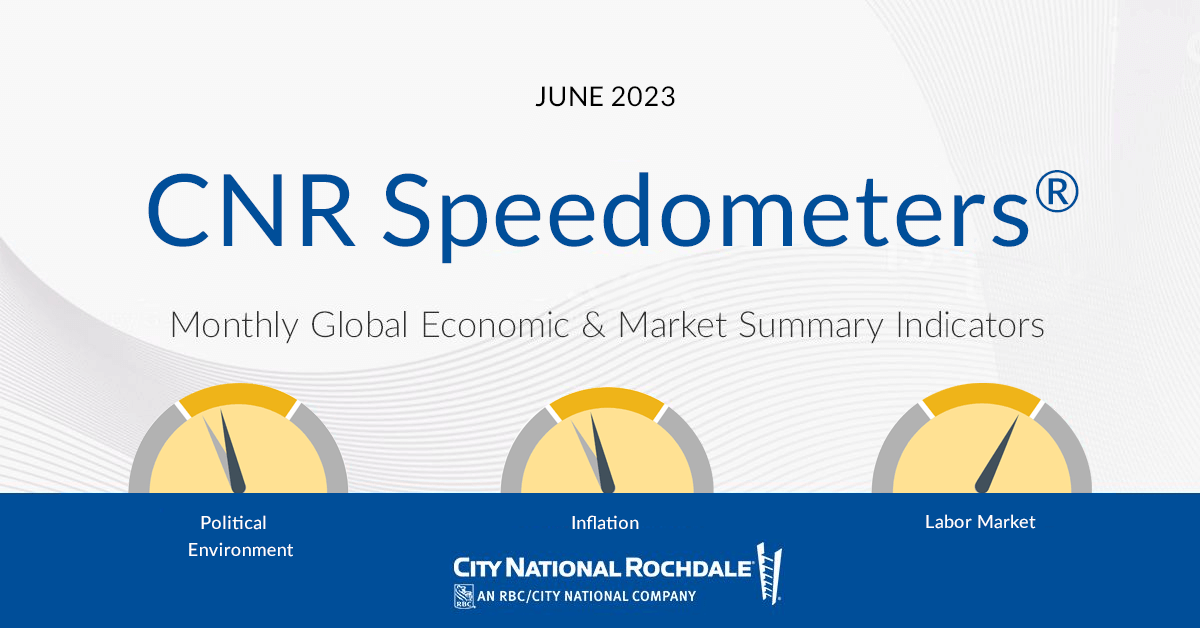
CNR Speedometers®
June 2023
Forward-Looking Six to Nine Months
TRANSCRIPT
The key takeaway for this month is that, while we have modest improvements to our inflation and political environment dials, the overall message of our speedometers remains the same, that risks of a mild recession remain high.
Let's dive into our changes, starting with the Political Environment dial: The most welcome news since our last update came out of Washington with a last minute deal to suspend the debt ceiling until January of 2025. Not only was the catastrophic default avoided, but the agreement surprisingly came with an overwhelming bipartisan support. It had been one of the most challenging political environments in years. The level of compromise witnessed during the negotiations bodes well for the upcoming budget appropriations, and the chances of a government shutdown have been avoided. Additionally, the suspension of the debt ceiling pushes the issue beyond the elections in 2024.
The fiscally responsible act had other modestly good news in it and that it is expected to reduce the deficit by one and a half trillion dollars over the next ten years, the first time in a while that the outlook for the deficit is going down. In the near term, there is a modest negative, the new government spending cap, and the $150 billion annual reduction in the deficit does add a modestly fresh headwind to the U.S. economy that's already burdened by the highest interest rates in decades and reduced access to credit. Federal spending in recent quarters has increased, helping to support economic growth. While the deal doesn't include significant spending cuts, it will likely at least dampen the recent benefits.
The second dial we modestly moved is our Inflation dial. The Fed's battle against inflation is far from over. While the Fed's preferred measure against inflation, the core PCE uptick modestly recently to 4.7, there are improvements in many key components that we see.
Goods inflation continues to move lower. Lower housing prices are finally working their way into measures of the so-called super core inflation and in our base case forecast for inflation, we're continuing to see a downward glide path. We expect inflation to gradually become less of a headwind over the second half of the year and provide a boost to real household wages. This potential tailwind for the consumers is part of the reason why we are expecting a mild recession.
Now, while we don't have any changes to report to you on the consumer dials, there's been some fresh economic data. Starting with labor markets, good news and bad news. The good news is the job market remains undeniably strong, the Job Openings and Labor Turnover Survey (JOLTS) data, ADP data, and the all important farm payrolls numbers were all above estimates. The economy remains vibrant and can readily absorb workers. Employment gains in May were broad based, led by professional services, government, health care, and other areas.
Bad news is, though, is that while wage growth cooled modestly to 4.3% in its most recent reading, it remains elevated and above the Fed's target. Let's take a look at the consumer spending dial. Consumer spending had good news and bad news. The good news is that in the month of April, spending was stronger than expected, reversing sluggish spending patterns in February and March. Strength was evident in both the goods and services.
The bad news is that consumers have increasingly turned to credit to maintain spending or taken down savings. Households are becoming increasingly cautious hunting for deals and focusing on key essentials. The excess savings, which at one point were well over $2.4 trillion, are now down to an estimated half a trillion dollars according to the San Francisco Fed, which may become a headwind for spending through the end of the year.
In conclusion, while the resiliency of the economy has certainly surprised many, we think it's unwise to dismiss concerns of a coming recession. As the color mosaic of our speedometer shows, risks of a mild recession remain high.



